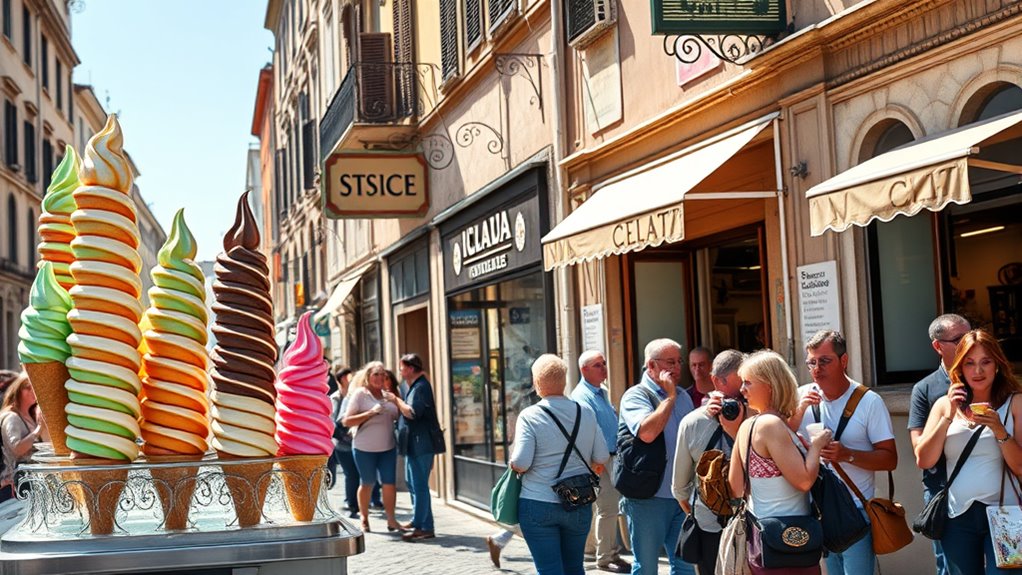To spot real Italian gelato and avoid tourist traps, look for small, family-run shops with visible fresh ingredients and natural flavors. Authentic gelato is crafted on-site, vibrant, and not artificially colored or overly smooth. Pay attention to price—if it’s too high or near major attractions, it’s likely a tourist trap. Friendly, knowledgeable staff who share their process also signal quality. Keep these tips in mind to truly enjoy genuine gelato—there’s more to discover if you stay curious.
Key Takeaways
- Look for small, family-run gelaterias with visible fresh ingredients and natural flavors.
- Avoid overly smooth, neon-colored, or overly sweet gelato, which signals mass production.
- Check prices; authentic gelato is affordable, while tourist traps often overcharge.
- Seek out passionate staff willing to share details about ingredients and craftsmanship.
- Choose local spots away from major attractions for fresher, more genuine gelato experiences.

Visiting popular destinations often means facing the dilemma of choosing authentic experiences over tourist traps, especially when it comes to enjoying local treats like gelato. You want to indulge in rich, authentic flavors that truly reflect Italy’s culinary heritage, but it’s easy to be lured into places that serve subpar gelato just to cash in on tourists. The key is to learn how to spot genuine gelato shops and avoid falling prey to price gouging. Authentic gelato isn’t just about the taste; it’s about the quality of ingredients, craftsmanship, and tradition. When you’re scanning for the right spot, look for small, family-run gelaterias with visible displays of fresh ingredients. These places often serve gelato made on-site with natural flavors, without artificial additives or excessive sugar. The flavor should be vibrant and true to the fruit or nut used, not artificially flavored or overly sweetened. If you notice bright, neon colors or overly smooth textures, those can be signs of mass-produced, low-quality gelato that’s more about quick profit than genuine flavor.
Choose family-run gelaterias with natural ingredients for authentic, flavorful gelato away from tourist traps.
Price gouging is another red flag to watch out for. In tourist-heavy areas, some vendors increase prices considerably, knowing that visitors will pay for the experience, even if the quality isn’t worth it. A good rule of thumb is to compare prices. If a gelato cone costs twice what you’d typically pay in a smaller, less touristy spot, you’re probably being overscharged. Remember, authentic gelato is usually affordable, especially if you choose local spots rather than those located right next to major attractions. Don’t be afraid to step away from the crowds for a moment; often, the best gelato is found in quieter, less commercialized neighborhoods.
Another way to guarantee you’re getting genuine gelato is by observing the staff. Passionate gelato makers take pride in their craft, and they’re happy to share details about their ingredients or the process. If they seem enthusiastic to serve you quickly without explanation, or if they’re hesitant to answer questions, it might be a sign that the quality isn’t a priority. Trust your senses—if the gelato looks and smells fresh, and the price feels fair, you’re probably on the right track.
Additionally, being informed about whole‑house water filtration systems can help you enjoy your travels more comfortably, as clean water is essential for savoring authentic foods and drinks without worry.
Ultimately, finding authentic gelato isn’t about avoiding all tourist spots but about being discerning. By paying attention to flavors, ingredients, and pricing, you’ll be able to enjoy the true taste of Italy without falling for tourist traps that prioritize profit over quality.
Frequently Asked Questions
How Can I Tell if a Gelato Shop Uses Authentic Ingredients?
You can tell if a gelato shop uses authentic ingredients by paying attention to its flavor and ingredients list. Authentic gelato features fresh, natural ingredients like real fruit, nuts, and high-quality dairy. When you taste it, it should have a rich, genuine flavor without artificial aftertaste. Ask about their ingredients if you’re unsure—places committed to authenticity will gladly share their sourcing, ensuring you enjoy a true, authentic gelato experience.
Are All Souvenir Shops in Tourist Areas Overpriced?
Not all souvenir shops in tourist areas are overpriced, but many do charge higher prices due to their shop location and tourist demand. To avoid overpaying, compare prices with local shops outside main tourist spots and look for shops that seem less commercial. Trust your instincts and check for authentic local craftsmanship, which often indicates fair pricing. Being aware of local pricing helps you find souvenirs that are both genuine and reasonably priced.
What Signs Indicate a Tourist Trap Restaurant?
You can spot a tourist trap restaurant by looking for signs like inflated prices, menus in multiple languages, and generic decor. Authentic ingredient indicators include fresh, locally-sourced dishes, traditional recipes, and clear ingredient descriptions. If the place seems overly crowded with tourists, offers photos on menus, or has staff aggressively urging you inside, it’s likely a tourist trap. Trust your instincts and seek out places with genuine signs of authenticity.
How Can I Avoid Buying Counterfeit Italian Products?
To avoid falling for counterfeit Italian products, focus on authentic craftsmanship and shop with local vendors you trust. Look for clear labels, official stamps, and familiar branding that signify genuine quality. Ask vendors about their products’ origins and avoid overly cheap items that seem too good to be true. Supporting local artisans guarantees you’re buying authentic pieces, helping you cherish real Italian craftsmanship instead of imitation souvenirs.
Are There Specific Neighborhoods Known for Genuine Experiences?
Yes, exploring neighborhoods like Trastevere in Rome or Brera in Milan helps you experience authentic local markets and neighborhood traditions. These areas are known for their genuine atmosphere, where locals shop and dine, giving you a true taste of Italian culture. Avoid tourist traps by wandering through these neighborhoods, engaging with vendors, and savoring local specialties that aren’t overrun with tourists. It’s the best way to enjoy real Italy.
Conclusion
Now that you know what sets genuine gelato apart from tourist traps, you can savor Italy’s true flavors without the hype. While shiny storefronts lure you in, trust your senses and look for authentic signs like natural ingredients and local recommendations. Just like the difference between a fleeting tourist trap and a lasting memory, choosing genuine gelato guarantees your experience is real and unforgettable. So, next time, pick quality over gimmicks and taste Italy’s true sweet side.









